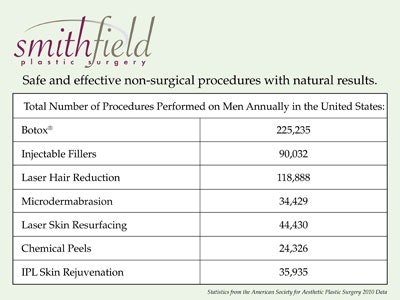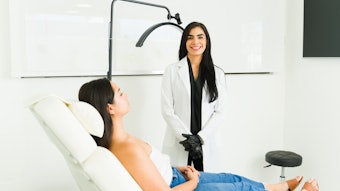
Although once taboo, men taking care of their skin is morphing from a metrosexual trend to the norm for many. Aging doesn’t just happen to women, and now more than ever men are realizing that they want to look as good as they feel. This new acceptance by this strong male market may have you reconsidering your tactics for reaching out to them. Gone are they days of trendy treatments; now is the time to ask yourself how you can help men become lifelong clients of your skin care facility.
Physician’s point of view: Steven H. Dayan MD, FACS
It has become increasingly popular for men to request cosmetic medical procedures, and many practices are missing out on this opportunity because they market specifically to women. A few years ago the term “metrosexual” became popular as a description for men who cared about their looks more than the average Joe. However, the popularity of this term has faded because men making themselves look better is now the norm. According to The American Society for Aesthetic Plastic Surgery, the number of cosmetic medical procedures for men has increased more than 88% since 1997. With cosmetic medical procedures on the rise, men are more likely to receive skin services to maintain the benefits that come with undergoing these procedures. The time has come to start looking at new and innovative ways to draw the male population into your facility.
It is well-known that women and men differ in many ways, so it is important to market differently to males than females. Unlike women, men may not admit to trying to look better, but they often cage it because they are trying to achieve something on a “big picture” scale. They may admit to be looking for a better job, more professional leverage or the opportunity to meet women; looking and feeling better will help them to achieve these goals. There are many books and studies written about how important first impressions are. In a study published in the November 2004 issue of Aesthetic Plastic Surgery, fellow colleagues and I found that altering the physical appearance of the face with cosmetic surgery would result in better first impressions. The study revealed that, following plastic surgery, patients typically were thought to have better social skills, increased dating and relationship success, and trended toward having an appearance consistent with greater occupational and financial success. In addition, they were perceived by some to be more intelligent and to have attained higher academic achievement. DeNova research performed two similar studies revealing similar results.
Building a strong male clientele can take some work for those facilities that are used to catering to women. Females generally like to know every detail and option to make themselves look better and, in turn, they will feel better. You have to think in a different mindset with men, who tend to be a bit more single-minded; they like facts and solutions. The facts would include what is happening to their skin and why. Maybe they are getting pigmentation and they don’t wear sunscreen. The solution would be to start receiving skin-lightening treatments and use products containing sunscreen. It’s as simple as that. Don’t overwhelm them with other treatments that may not address one of their concerns.
Esthetician’s point of view: Terri A. Wojak
Building a male clientele is easy to do if you take the proper steps. Men tend to be very loyal clients, and it will give you the upper hand when increasing your business. It takes six to seven more attempts to gain a new client than to retain an existing one and, because men often become regular clients, it will help to build your business as a whole. When trying to build your male business, remember these important tips:
- Keep it simple;
- Provide facts; and
- Make them feel comfortable.
Men typically prefer simplicity, so make sure that the treatments you offer are quick, easy and show results. There are many services to offer men that meet these criteria. Laser hair removal is one of them. Many men are concerned with excess hair on their backs, chests and shoulders. There are new laser devices that are much quicker and easier to use than older technologies that are time-consuming and painful. One such laser allows the entire back to be treated in as little as 20 minutes, and it is virtually painless. This is not only a great service to offer, but it has been proven to get male clients in the door so they can be educated about other services.
There are many treatments available to improve the appearance of the skin, but there are a few options that men would be more apt to receive. For instance, microdermabrasion may be a better choice for a man than a chemical peel because you can feel and see an immediate result, there is no after care and it’s a simple, quick procedure. Although chemical peels are quick and easy, there are many steps involved in caring for the skin after the treatment, so you shouldn’t offer this treatment at a first appointment.
When it comes to product recommendations, be sure to make their routine simple, as well. You can relate home care to a fitness regimen. Many men work out on a regular basis to keep up their physique. Explain that home skin care is the same idea; they can’t just do it once and get long-lasting results—they have to do their part at home. There are many male-specific products on the market that are making men more open to taking care of their skin on a regular basis. At the very least, ensure that your clients are using a foaming cleanser and oil-absorbing matte moisturizer with sunscreen. Never start male clients out with more than a three-step regimen; it may overwhelm them, especially if they are used to just soap and water.
All clients, female and male, should be educated properly about what you are doing to their skin, but men need just the facts. Let them know exactly why you chose the treatment you are recommending, what it entails and how to care for their skin after the treatment. For example, say: “A facial can help to decrease the amount of dead skin on the surface and provide a thorough cleansing of your skin. I will be performing extractions to decrease congestion from your pores, followed by a skin-tightening mask.” Then explain the steps as you are performing the treatment. This gives the clients all of the information they need without too much thought or confusion.
Men used to go to barbershops because they felt more comfortable there than in salons where the majority of the clients were women. Times have changed, and today there are many spas and salons that are specifically for men, which makes it more comfortable to go to without feeling it is too feminine. To cater to both genders, treatment rooms should be kept neutral; an overly feminine ambiance might make a man feel uneasy. Advertisements should feature male-specific services, such as a Men’s Grooming Facial or even a Skin Fitness Series. These tips and tools will allow you to build a successful male clientele while providing the best services for their individual needs.
Marketing point of view: Tracy L. Drumm
When trying to reach the male market, the keys are to get back to the basics and simplify your efforts. Begin by understanding that, although the exterior of the collaterals and promotional materials for your male market should differ from your female clientele, the core principles of marketing remain the same. Start addressing the question “What’s in it for me?” from the clients’ point of view. Create brochures, Web pages or fliers to promote how your services make your male clients’ lives easier.
Two specific tools that help effectively grab the attention and market share of the male population involve peer influence through numbers and speaking through female clients. Get rid of the aspirational branding approach featuring a beautiful woman’s rejuvenated face; instead, give your tools some masculinity. This doesn’t mean your tools need to tout cars, sports or other cliché male advertising imagery. Rather, make the tools less feminine so the men in your waiting room are not intimated to pick up your materials. Clearly branding things for the male market will help them feel more comfortable taking the leap of faith and picking up the consultation guide while visiting your facility.
There is power in numbers, especially when it comes to something as novel as male cosmetic treatments. Display statistics that help educate the women and men coming through your facility about just how many guys around the country are ridding themselves of their pesky crow’s-feet. You might be surprised to learn how many men are trading in beers and brats for waxing and peels.
It’s no secret that an easy way to reach a man is often to pique the interest of his spouse or significant other. Promote the availability of services specifically for men throughout your facility, then add a tool with a call to action. A referral card for men is an easy way to turn in-facility promotions into an external marketing tool that brings new clients through the door. Have these available for your clients to share with the men in their lives.
It is a common rule for promotions that marketing is not one-size-fits-all. What works well in one area of the country may produce mediocre results elsewhere. Remember, when experimenting with your gender-based marketing to test before you invest. Try smaller, less expensive promotions before diving into pricey campaigns. Most importantly, track what does work so you can keep men lining up for your services.
Steven H. Dayan, MD, FACS, is an expert and leader in the field of facial plastic surgery, and is a member of the American Academy of Facial Plastic and Reconstructive Surgery. His passion for education led him to open True University, a Chicago training center that teaches estheticians how to appropriately work with physicians. Dayan is a 2010–2011 member of the Skin Inc. magazine editorial advisory board.
Tracy L. Drumm manages the day-to-day operations of IF Marketing, a Chicago firm specializing in aesthetic medicine. Drumm recently co-authored Keys to Success: Marketing & Practice Management (College of Cosmetic Medicine Press, 2007) and Thrive: Pearls to Prosper in Any Economy (College of Cosmetic Medicine Press, 2009).
Terri A. Wojak is a licensed esthetician with more than 14 years of experience. She has knowledge in all aspects of the skin care industry, including education, sales, medical aesthetics, management and ownership, and she is the director, as well as an educator, at True University in Chicago.
Making stats available to male and female clients throughout your facility can emphasize the fact that skin care treatments for men are becoming the norm.












